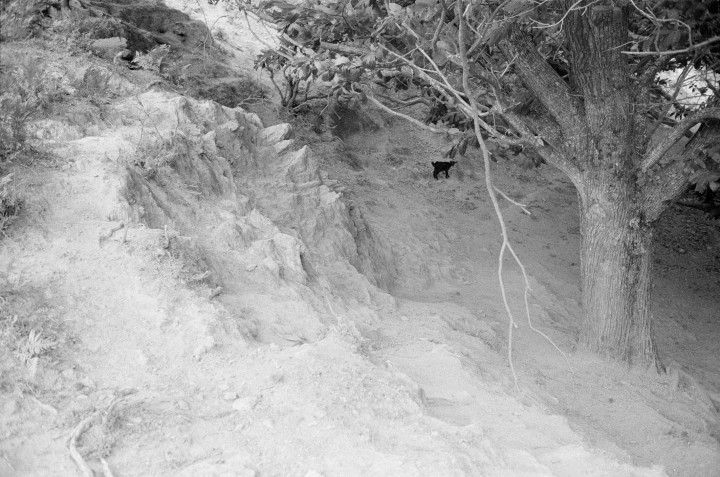The photographer has been sleeping for the longest time, exhausted from traveling in a windstorm. She awakes at noon and leaves the village for a walk.
Seeking relief, shade, the photographer ventures into the woods. The path crumbles into a blanched gulley of dry soil and roots. Very steep. Her sandals, useless here, are pulled off. She feels the solidity and reassuring pain of the earth against her bare skin. The camera is heavy and bulky. She doubts her own intention to carry it there. Why can’t she just experience: there is no need to justify her presence there. Yet she feels that need.
We did not ask to be here. We did not choose this life we have, this planet.
And yet, somehow, we feel the need to justify.
The goat is small. Tiny. Utterly dark. Has she seen something? In her still darkness, she is aware of something. At times, she bleats into bright silence. She is lost, maybe. Or the photographer is lost.
The kid looks fragile, out of balance. Still, her bleating is firm. She knows how to be alive there. Do we?
The photographer stops, takes a picture.
Look again: In the blanched earth, amid drought, we look for the tree to find water, our connection to the earth. The tree. The animal, a fellow animal, the small black bleating heart of us. Flora and fauna.
And again: We lay back in the shade with the satyrs, celebrate our bodies, our profligacy, falling like Debussy into the lazy Afternoon of a Faun. We flute and dance with the old goat, Pan, oldest of the domesticated food animals, 10,000 years of uneasy marriage.
In goats, we celebrate our most ancient connection to this planet, this place.
We sacrifice the Yule Goat. Do we, like Thor, whose carriage was pulled by goats, who ate their meat every night and saw them rise again from their bones every morning – do we honour the bones?
And again: In that most ancient of zodiacs, the Chinese, the goat and sheep commingle and return to their evolutionary unity, charming and creative, elegant and fond of nature.
Who was born in the Year of the Goat? Michelangelo, Mark Twain, Thomas Alva Edison, Muhammad Ali, Rudolph Valentino, Rachel Carson, Pierre Trudeau, Barbara Walters, Orville Wright, Nicole Kidman, Julia Roberts, Amy Lee, Bruce Willis, Benicio Del Toro, Claire Danes, Jamie Lynn Spears, Matt LeBlanc, Chow Yun-Fat, Zhang Ziyi, Li Shimin (Emperor Taizong of the Tang Dynasty 618 – 907), Cao Cao (King of Wei in China’s Three Kingdoms Period 220 – 280), Yue Fei (a patriotic general in China’s South Song Dynasty 1127 – 1279), Empress Dowager Cixi. Can you find a pattern? The pattern is human. This is all of us, the sheep-goat, lost in the phantasmagoria of our imaginations, in the bleakness of the landscapes we create.
In the Western zodiac, the Capricorn is a chimera, a modern goat, genetically manipulated, fish-tailing up to the mountain top. We are all capricorns, ambitious, children of Descartes, who wished nothing less for his kids – for us – than to be “the lords and possessors of nature.”
Look again: See the tree – all that firewood to split! The Great Unnamed demands we split ourselves, demands a sacrificial lamb. Two goats are chosen, one has his throat slit, one zig-zags free into the desert: the scapegoat. The goats go to hell, the sheep, to the heavenly fold. Descartes’ dualism rules. All we like sheep have gone astray.
We wander, lost at the edge of the light, looking into the oasis. The tree is there, the deep roots to the depths of the drought, to the source. The goat, the heart of us, the little back heart, bleating. There go our kids, our future.
We see a tree and a small animal: our primal connections to the planet, to each other. We see water, food, clothing: shade, milk, meat, skin, a scapegoat for our abuse. What are we willing to sacrifice, and for whom?
Whose kid is that? Does it matter?
We speak of One Health, and Health for All. But who are “we”? And what sacrifices of others’ health is demanded by a sense of entitlement for our own health?
In the trust of sharing food and water we find ourselves. When the wind dies and the clouds hold their watery breath, in that open, dry silence we hear the voices of those who dwell with us.
Antonio Gaudi sipped goats’ milk for his health, Brucella melitensis swimming in the milk. Suffering thrives in the very material of life. Is this not at the heart of our dilemma? That the very things that give us health and life also remind us of our mortality? The WHO, in its 1948 constitution, says that health is not merely the absence of disease or infirmity, but a state of complete physical and social wellbeing. Can it be that, sometimes, social wellbeing thrives on infirmity? In the grip of undulant fever, unconsciously carrying the contradictory and complex image in his body, Gaudi imagined the Sagrada Familia, a celebration of the complex and contradictory connections among all living things.
But come back and look again. See the white, hard earth, the tree, the broken path. Pause a moment. The wind bates its breath. Burning hot. That ancient conversation, air and fire, the hot breath of being and memory riffling the hair on her arms.
On such a day, we are struck dumb.
///
David Waltner-Toews and Alice Benessia 2014
EcoHealth / Cover Essay / September 2014 / Volume 11 / Issue 3 / pp. 446-447
